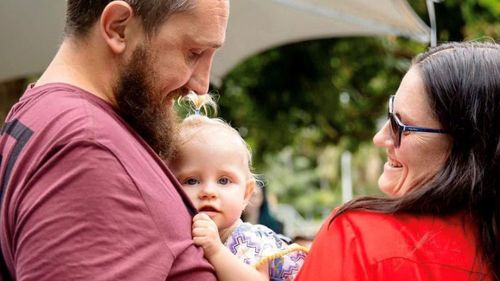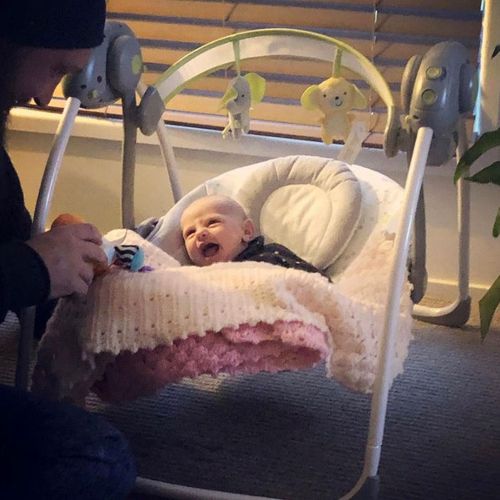Parents and advocates are calling on the government to address an inequality rooted in its parental leave scheme which they say punishes female breadwinners and stay-at-home dads.
Currently, if a mother earns more than $150,000 a year, neither she nor her partner is eligible for the government’s Parental Leave Pay.
But the income test for the scheme – which amounts to 18 weeks’ pay at minimum wage or around $13,800 – is only applied to the mother’s earnings.
The father, meanwhile, could take home a salary of millions and the mother will still qualify for Parental Leave Pay, provided her income is below the $150,000 cap.
It was a situation which dismayed Brisbane couple Neal Baker and Natasha Underdown when their daughter Willow was born.
Ms Underdown works as a financial services contractor and, as a temporary worker, was not eligible for any parental leave from her employer.

A payout from her previous employer earlier in the year, including long service leave entitlements, meant her income came in just above the $150,000 threshold.
Mr Baker, who was working as an electrician at the time and earning less than $150,000, always planned to become a stay-at-home dad when Willow was born.
“It sort of made sense with the wage gap between me and Natasha that I would be the one to take time off work. It was a great opportunity for me to stay at home,” Mr Baker said.
After Willow was born, the couple went into a Centrelink office to see if Mr Baker would qualify for parental leave but was told he would not.

The couple then contested the decision at the Administrative Appeals Tribunal, twice, but were knocked back both times.
“We were obviously gutted,” Mr Baker said.
“We chose to do it this way.
“I don’t see why the man can’t be paid.
“It’s not called mother’s leave anymore like it used to be. It’s called parental leave.
“It was like a kick in the teeth and really disappointing.
“It’s ridiculous. Everyone is pushing women to go back into the workforce for the greater good and they are not rewarding them for that.
“There shouldn’t be discrimination anywhere in this and this is just blatant discrimination.”
Mr Baker said he ended up spending eight months at home, before transitioning to a new job in retail part-time.

Thousands sign petition for change
So far, more than 3300 people have signed the petition.
Last year, Ms Underwood and Mr Baker started a similar parliamentary petition about the same issue, which attracted almost 700 signatures.
In response to Dr Bailey’s petition, a spokesperson for the Department of Social Services told nine.com.au in a statement the government’s Paid Parental Leave Scheme was designed to complement employer-based schemes and allow parents to spend quality time with their child after birth or adoption.
“The scheme’s income test recognises that women who are on a higher income and are primary carers are in a stronger position to obtain paid parental leave and other family-friendly benefits as part of their conditions of employment,” the statement said.

Parents at Work CEO and founder Emma Walsh said legislation for the government’s parental leave scheme was introduced a decade ago at a time when the needs of dads were considered an afterthought.
“What we have at the moment isn’t in step with what we would like to see, which is equal access to paid parental leave,” she said.
“It also falls short of imaging any other way a child might arrive in a family in terms of same-sex families, who aren’t really addressed specifically.”
Rather than tweaking at the edges, wholesale reform was needed in order for Australia’s parental leave offering to be brought in line with other OECD nations, Ms Walsh said.
“In many countries, there is an element of leave put aside for both parents and then a separate element put aside for them to share.
“I think that would be ideal. And would keep us in more in line with best practice amongst other OECD nations.”
Liberal MP agrees it should be parents’ choice
The parental leave inequality was raised on the ABC’s Q&A program last week, with Jenna Patterson, a new mum to twins, revealing she and her partner had lost out because she is the family’s main income earner.
Liberal MP Fiona Martin told the program she had raised the issue with the Minister for Social Services and Families, Anne Ruston, but did not receive a positive response.
“I agree with the lady that’s asked the question and I think that it should be changed, that we should have an even playing field between parents,” Ms Martin said.
“I didn’t get the response that I wanted [from Ms Ruston].
“So I’m hoping to still change it and I’m confident that we should move in that direction because it should be a choice that parents make, which parent goes back to work.”
Last year, Centre Alliance Senator Stirling Griff proposed an amendment in the Senate which would have allowed partners would be able to apply for Parental Leave Pay if the mother does not meet the income test.
The amendment was voted down by the government and One Nation.
Contact reporter Emily McPherson at emcpherson@nine.com.au.
This content first appear on 9news
